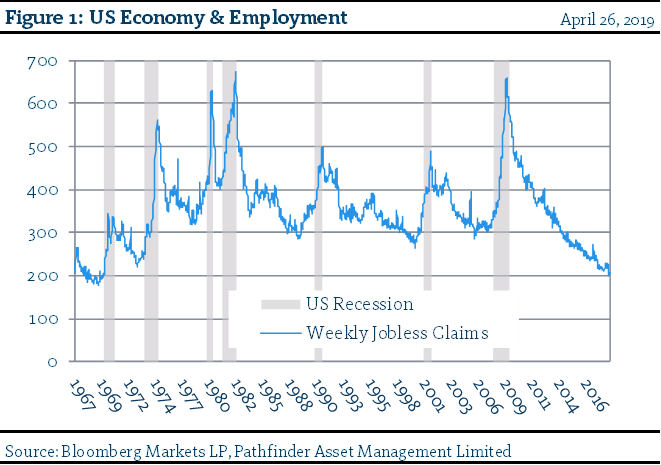Recap & Outlook: Global Economy
Two weeks ago, we wrote about US employment and noted that it has been strong. Employment is a good indicator for the US economy and the Weekly Jobless Claims report is our preferred employment measure. Claims tend to give a very good picture of the current health of US employment and, in combination with other measures, the US economy. This, in turn, can flow into the rest of the world. Claims figures are low again meaning Americans claiming new unemployment is low. This is good as long as inflation is low as well. We do not look at a single data point when drawing investment conclusions; so this week, we examine the data in more detail.
- We plotted the data again, but this time we focused on the four-week smoothed line to get a better idea of the context of the trend (Figure 1). The smoothed line fell to 201k last week which is the lowest reading since November 1969 (the start of the data set).

- When one considers the difference between the size of the workforce in 1969 and today, the magnitude of current employment strength is impressive. The labor market is moving to very low levels of unemployment and has done so consistently since the end of the recession in 2009.
- It is more difficult to interpret central bank intentions, and data in general, for this economic cycle because of the follow-on effects in financial markets from the Great Financial Recession of 2008/9. Quantitative easing measures implemented by all of the large central banks have skewed natural relationships. For example, the US Federal Reserve used to hold just under $1 trillion in assets before 2009 and now have $3.9 Trillion, previously peaking at $4.5 Trillion in 2014. While some of this will wind down over time, market participants expect the FOMC to maintain a $3-3.5 Trillion reserve in perpetuity. This is a new development, which impacts the price of all financial assets and appears to be permanent. We also note that the FOMC is now using interest on bank reserves as a way to slow administered rate increases. This is a new development for this economic cycle which we will spend more time on next week.
“This means that” with low inflation and strong employment, we believe there should be less concern about US recession over the short-term. It is not until inflation increases out of control that central banks react. Other than an unforeseen financial crisis, this is when we have to worry that the economic cycle may be coming to an end. “The market” obviously missed this at the end of last year, which reinforces for us why we focus on our fundamental investment management process.
National Instrument 31-103 requires registered firms to disclose information that a reasonable investor would expect to know, including any material conflicts with the firm or its representatives. Doug Johnson and/or Pathfinder Asset Management Limited are an insider of companies periodically mentioned in this report. Please visit www.paml.ca for full disclosures.
*All returns are time weighted and net of investment management fees. Returns from the Pathfinder Partners’ Fund and Partners’ Real Return Plus Fund are presented based on the masters series of each fund. The Pathfinder Core: Equity Portfolio and The Pathfinder Core: High Income Portfolio are live accounts. These are actual accounts owned by the Pathfinder Chairman (Equity) and client (High Income) which contain no legacy positions, cash flows or other Pathfinder investment mandates or products. Monthly inception dates for each fund and portfolio are as follows: Pathfinder North American: Equity Portfolio (January 2011), Pathfinder North American: High Income Portfolio (October 2012) Pathfinder Partners’ Fund (April 2011), Pathfinder Real Return Plus Fund (April, 2013), Pathfinder International Fund (November 2014) and Pathfinder Resource Fund (May 2018).
Pathfinder Asset Management Limited (PAML) and its affiliates may collectively beneficially own in excess of 10% of one or more classes of the issued and outstanding equity securities mentioned in this newsletter. This publication is intended only to convey information. It is not to be construed as an investment guide or as an offer or solicitation of an offer to buy or sell any of the securities mentioned in it. The author has taken all usual and reasonable precautions to determine that the information contained in this publication has been obtained from sources believed to be reliable and that the procedures used to summarize and analyze such information are based on approved practices and principles in the investment industry. However, the market forces underlying investment value are subject to sudden and dramatic changes and data availability varies from one moment to the next. Consequently, neither the author nor PAML can make any warranty as to the accuracy or completeness of information, analysis or views contained in this publication or their usefulness or suitability in any particular circumstance. You should not undertake any investment or portfolio assessment or other transaction on the basis of this publication, but should first consult your portfolio manager, who can assess all relevant particulars of any proposed investment or transaction. PAML and the author accept no liability of any kind whatsoever or any damages or losses incurred by you as a result of reliance upon or use of this publication.